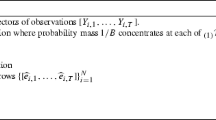Abstract
Testing for linearity in the context of Markov switching models is complicated because standard regularity conditions for likelihood based inference are violated. In particular, under the null hypothesis of linearity, some parameters are not identified and scores are identically zero. Thus, the asymptotic distribution of the relevant test statistic does not possess the standard χ 2-distribution. A bootstrap resampling scheme to approximate the distribution of the relevant test statistic under the null of linearity is proposed. The procedure is relatively easy to program and computation requirements are reasonable. The performance of the bootstrap-based test is investigated by means of Monte Carlo simulations. Results show that this test works well and outperforms the Hansen test and the Carrasco et al. test.
Similar content being viewed by others
References
Albert JH and Chib S (1993). Bayes inference via Gibbs sampling of autoregressive time series subject to Markov mean and variance shifts. J Bus Econ Stat 11(1): 1–15
Carrasco M, Liang H, Ploberger W (2004) Optimal test for Markov switching. Working paper, University of Rochester
Cecchetti SG, Lam P and Mark NC (1990). Mean reversion in equilibrium asset prices. Am Econ Rev 80: 398–418
Cosslett SR and Lee LF (1985). Serial correlation in latent discrete variable models. J Econ 27: 79–87
Engel C and Hamilton JD (1990). Long swings in the dollar: are they in the data and do the markets know it?. Am Econ Rev 80: 689–713
Feng ZD and McCulloch CE (1996). Using bootstrap likelihood ratios in finite mixture models. J R Stat Soc Ser B 58: 609–617
Garcia R (1998). Asymptotic null distribution of the likelihood ratio test in Markov switching models. Int Econ Rev 39: 763–788
Garcia R and Perron P (1996). An analysis of the real interest rate under regime shifts. Rev Econ Stat 78: 111–125
Goldfield SM and Quandt RE (1973). A Markov model for switching regression. J Econ 1: 3–16
Goodwin TH (1993). Business-cycle analysis with a Markov-switching model. J Bus Econ Stat 11: 331–339
Hamilton JD (1988). Rational-expectations econometric analysis of changes in regime: an investigation of the term structure of interest rate. J Econ Dyn Control 12: 385–423
Hamilton JD (1989). A new approach to the economic analysis of nonstationary time series and the business cycle. Econometrica 57: 357–384
Hansen BE (1992). The likelihood ratio test under nonstandard conditions: testing the Markov switching model of GNP. J Appl Econ 7: S61–S82
Hansen BE (1996). Erratum: The likelihood ratio test under nonstandard conditions: testing the Markov switching model of GNP. J Appl Econ 11: 195–198
Kim CJ and Nelson CR (1999). State-space models with regime-switching: classical and Gibbs-sampling approaches with applications. The MIT press, Cambridge
Lahiri K and Wang JG (1994). Predicting cyclical turning points with leading index in a Markov switching model. J Forecast 13: 245–263
Lam P (1990). The Hamilton model with a general autoregressive component: estimation and comparison with other models of economic time series. J Monet Econ 26: 409–432
McLachlan GJ (1987). On bootstrapping the likelihood ratio test statistic for the number of components in a normal mixture. Appl Stat 36: 318–324
Otranto E and Gallo GM (2002). A nonparametrc Bayesian approach to detect the number of regimes in Markov switching models. Econ Rev 21: 477–496
Psaradakis Z (1998). Bootstrap-based evaluation of Markov-switching time series models. Econ Rev 17: 275–288
Psaradakis Z and Spagnolo N (2003). On the determination of the number of regimes in Markov-switching autoregressive models. J Time Ser 24: 237–252
Sclove SL (1983). Time-series segmentation: a model and a method. Inf Sci 29: 7–25
White H (1982). Maximum likelihood estimation of misspecified models. Econometrica 50: 1–25
Author information
Authors and Affiliations
Corresponding author
Rights and permissions
About this article
Cite this article
Di Sanzo, S. Testing for linearity in Markov switching models: a bootstrap approach. Stat Methods Appl 18, 153–168 (2009). https://doi.org/10.1007/s10260-007-0080-6
Accepted:
Published:
Issue Date:
DOI: https://doi.org/10.1007/s10260-007-0080-6



